大头花
都是些琐碎的小事。以后读起来,给自己找个乐子。We reached Te Anau in early afternoon. The lakeside town looked clean and well-kept, but deserted. Many of the southern towns fared similarly around spring time. There will be more life here in a few months when the trails are fully open and the lake water warm enough to swim. Except for a few well positioned ones, most of the restaurants looked like that they would be lucky to get half a dozen customers in a day.

We found this wonderful restaurant while strolling the empty streets. The smell drifting from its doors could only be described as heavenly. That immediately made up our minds for us. And the food did not disappoint. Tracy ordered lamb shanks (she’s been babbling about it for much of our trip, and finally got her wish). I got pork ribs. They were both excellent. I knew the lamb would be good – NZ is famous for lambs, but was mildly surprised to find the ribs equally impressive. It’s a smart thing to follow your noses sometimes.

Local variety of lemonade

This rack of ribs is mouthwatering good

Te Anau has its own Great Walk (Department of Conservation’s highest rated walking tracks) – the Kepler Track. Too bad we didn’t have time for it this time. Instead we would walk the Hump Ridge Track a few hour’s drive to the south.
Lake view on the way from Te Anau to Tautapere

Hump Ridge is a privately managed track. The charge is $130 per person for a 3-day walk, which included lodging at two of their well managed huts, and breakfast of hot porridge. There’s a huge plus also – there are showers in these huts. You pay dearly for it. It’s $10 for 4 minutes, but at the end of a long and sweaty day of hiking, that seemed like a small price to pay. We just didn’t know if 4 minutes if enough. I guess we will find out.
We registered with the Hump Ridge office in the town of Tuatapere, then headed for a local B&B with an interesting name – Wicked Wee Dump. There were no sign outside, and we passed the place at least 4 times before finally found it. The place is a hidden gem. It was well worth the trouble. Our host, Janice, had everything ready for us.
Home made cake decorated with fresh flowers from her garden

Cozy room, soft bed and bright sunshine, Tracy is reading the guest book

Kitcheon is small but well equipped, and clean

Janice's homemade breakfast - poached pears, fresh fruits, yogurt, toast, milk, orange juice, honey - it's oh so delicious

he place was small, but clean and cozy. There were also 4 sheep in the backyard whom we had a lot of fun watching and joking about. They would make an appearance later. Janice was also kind enough to spoke to her neighbors who were sheep farmers to let Tracy pet one of their sheep. We must have looked silly to the neighbors. Regardless, Tracy got her wish and wool is not as soft as we thought it would be, mostly because the sheep was dirty 
The reason Janice didn’t let us pet her own sheep was probably that she couldn’t catch them. Sheep shy away from people, particularly their owners, who might be coming to sheer them, or give them a shot, or worse. We’ve seen them run from the sight of farmers and sheep dogs and hid in the bushes. It was quite funny to watch.
We started the first day of the track at 8 sharp. The track would pass through some forests, then 3km of sandy beaches, followed by more forests, and finally climbing 900 meters in 6km up above the tree line. Total length was 18km. It was possibly the most challenging day of hiking we have ever done. The Grand Canyon hike was longer, but it was a day hike, and we did not have heavy backpacks on our back. By the time we reach the first hut we were completely spent. Our packs were especially heavy today because we carried fresh fruits and veggies with us. It paid off handsomely. We each had a full plate of delicious Mexican risotto and my home-made fried rice. This and the hot shower recharged us enough for another half-hour walk around a scenic loop close to the hut.
167 stairs leading down to the beach

Wide open beach in the early morning light. It's scattered with beautiful pebbles.
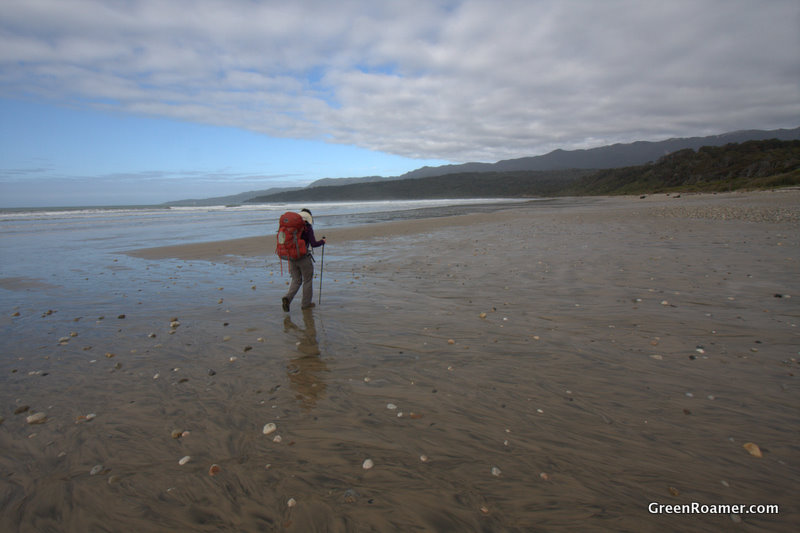
Tree damage to the track

You can see the deep ravine below. Not good for someone afraid of height.

While resting at the Water Bridge during the first day, a naughty Tomtit dropped in for a visit. Like many other New Zealand bird species, they are not afraid of people. We just looked like possible food dispensers.
View from Stag Point at 760m

This is why it's called stag point

Finally, the hut, we were hurting by now

View from the scenic loop above the hut.

The second day was mostly down hill. The distance remained the same at 18km. Thanks to our hiking poles, our knees held nicely. The track was a little slippery after light rain overnight. Tracy broke one pole in a fall, and torn a hole in her pant near the right boot on a tree branch. She sulked for 5 minutes each, and was cheerful again soon.
Downhill was much less of a challenge. We got to the second hut by 3pm, then went out to the beach close by. There were a group of Hector’s Dolphins in the water not 30m from us. We were able to watch them for a while before we were driven off by hordes of sandflies.
We had not seen many mosquitoes in NZ, but they were replaced by sandflies, which were much more ferocious. Mosquitoes at least try to circle around and sneak in, these guys went straight for the kill. They also work faster. A few seconds was all it took to get another red bump on your skin. The only saving grace is that they are not everywhere. They usually appear around sandy beaches, and that’s how they got their names. They also appeared to be more stupid than mosquitoes. We managed to kill every sandfly that got into our room, all 30 of them, and almost all on the window panes. As a result of this glorious victory, we had a peaceful night of sleep despite the hundreds that still lurked outside. Tracy also managed to patch up her torn pants, and did a real good job of it.
Rocks of the scenic loop in a beautiful morning

A small clear pool on top of the mountain
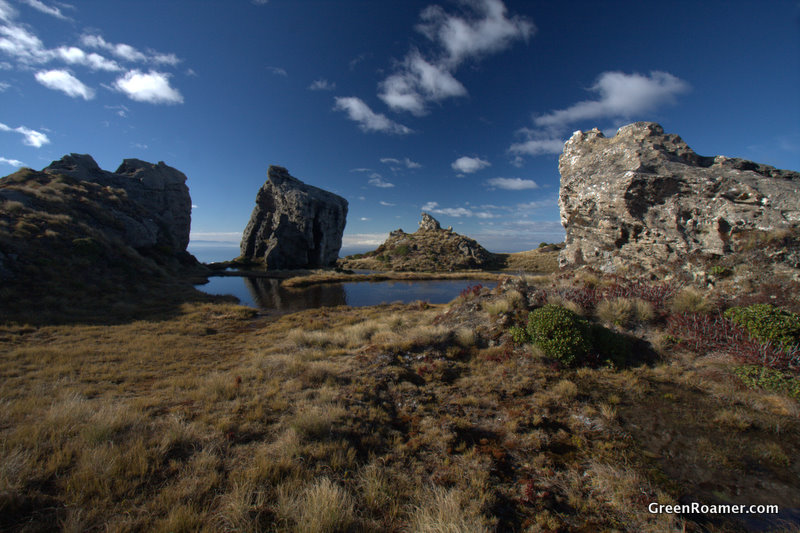
Views from a large rock on our way down

Third day was even easier. It’s 17km of mostly flat trails, with large portion of it alone a abandoned railway track. This area used to be the biggest lumber yard in New Zealand in the 1920s. The yard closed in less than 10 years because of depression. The railway was mostly overgrown over the years, though some sections were still visible.
Nope, it's not potato. It's a deadly mushroom called King's Pouch. Don't even touch it.
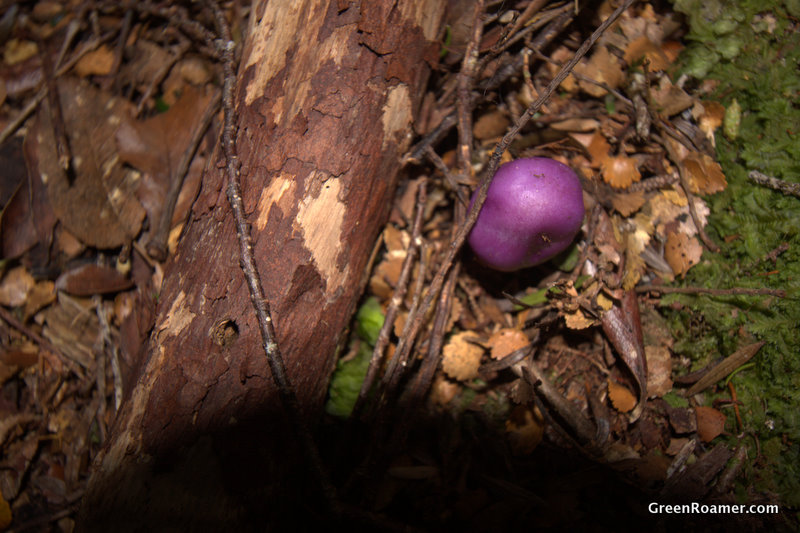
This is said to be the largest wooden viaduct today

Brief rest in a hunter's hut.

Here the remains of railway tracks are still visible.

We got back to Janice’s place at around 2pm. She was surprised that we got back so early, but got the breakfast tray for us quickly after. For dinner we cooked up bacon and scallops we bought from local grocery store. It was delicious. I deserve a pat on the back. By the way, Tuatapere is the self proclaimed Sausage Capital (of New Zealand?). We got half a kilo for $6, it’s not bad at all.
Janice’s husband, Trevor, also came by to say hi. He worked as a trucker, and is also good at growing things. All of the flowers and veggies we saw in their gardens are Trevor’s handiwork.
I said they will make an appearance - guarded looks toward the man aiming with a big camera

Yup, there are more than 4 now. Janice has her son's 4 sheep here as well, ready to be sheared. The second guy from right looks so ... different.

We said goodbye to Janice the following morning. This was to be another long day of driving. Our first stop was Moeraki, a town known for large round boulders on its beaches. The rocks were certainly impressive to look at. Some of them were almost perfectly round. It’s not surprising that the first people who saw these thought they were man-made.
We were delayed a little while by a bicycle race

We pulled over at this tulip field alone the highway. It's a sight for sore eyes.

Much of the flowers were already harvested. Otherwise this would be even more pretty.

The boulders formed millions of years ago in sandstone layers under the ocean. After the entire layer rose out of the ocean, the softer sandstone were slowly washed away, and the boulders were left on the beaches. There are still many of them buried in the remaining sandstone cliffs next to the ocean. They will slowly appear when the ocean chips away at the cliff little by little. Mother nature never fails to surprise us with what she could do.
Tracy walks around a half-buried round boulder

This one was cracked open by the elements

A tiny one

Now, we all know she has Herculean strength - I suppose we had to pay for this.

On a cool but sunny day, it's quite comfortable on the warm surface of this rock


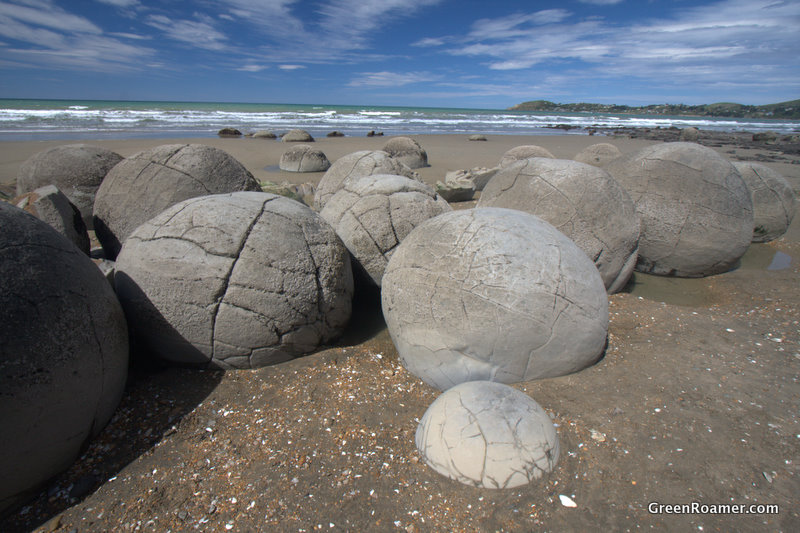
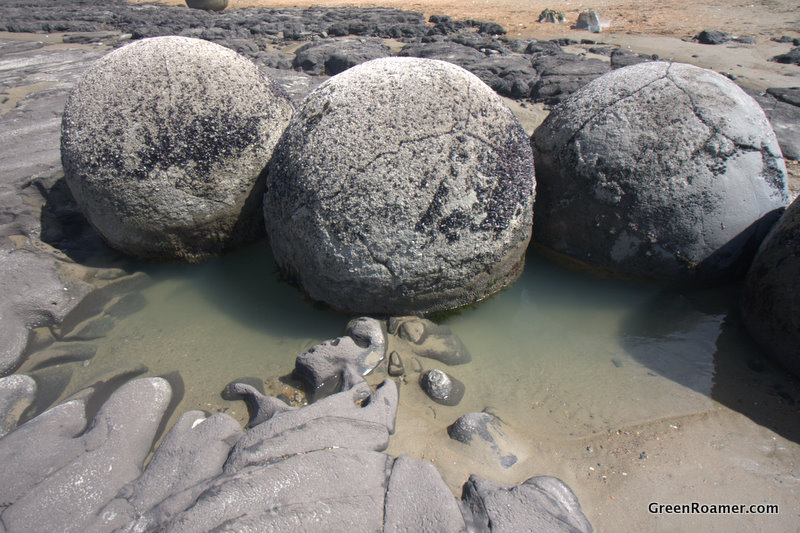

Next stop is Twizel, a moderate sized town at the gate of Mount Cook National Park.




